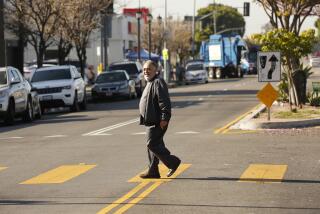Op-Ed: Hey, Manhattan Beach, preventing pedestrian deaths is more important than your speedy morning commute
All hell has broken out in my adopted hometown of Manhattan Beach. If you believe the hysteria, families are being torn apart, livelihoods are being threatened and businesses are in danger of collapse. All because in early June, Los Angeles slowed traffic on several roadways in Playa del Rey, including removing one lane on each side of Vista del Mar, the thoroughfare that runs along the ocean from El Segundo to Playa.
South Bay commuters are livid that rush hour traffic is worse. They claim workers will permanently lose five hours of family time a week (even though no formal traffic study has been conducted). Silicon Beach tech entrepreneurs and private equity guys are sounding the alarm on Twitter that new traffic jams will harm recruitment. At a town hall with Manhattan Beach’s mayor, real estate agents speculated that home values might sag (in a town where the average home costs $2.2 million). A GoFundMe page was launched to raise money for a lawsuit and the Manhattan Beach City Council unanimously directed city staff to support that effort.
Absent from this heated conversation, however, is honest talk about what is really at stake along Vista del Mar: Preventing people from dying.
The changes on Vista del Mar — and portions of Culver Boulevard, Jefferson Boulevard and Pershing Drive — are part of the multinational “Vision Zero” project that has successfully cut down on accidents and deaths by slowing traffic. The reconfiguration in Playa del Rey — a “road diet” — came on the heels of a wrongful death suit the city of Los Angeles settled for $9.5 million with the parents of a 16-year-old who was killed trying to cross Vista del Mar. According to L.A. Department of Transportation data, no fewer than 354 crashes involving injuries occurred along the impacted roadways between 2003 and 2016, leaving 14 people dead.
The consensus appears to be that pedestrians and cyclists dying is acceptable collateral damage, as long as these commuter routes run as fast as possible.
What it is about safety that my neighbors don’t get? I’m an avid cyclist and I commute on my bike. I’ve biked 24,000 miles in L.A. in the last three years, and I’m viscerally aware of the plight of vulnerable road users in the city — seniors who struggle to speedily cross intersections and children riding to and from school. Even with the new road diet in place in Playa del Rey — complete with new bike lanes — I will avoid the heavy traffic there. The battle over this project has little to do with bikes and everything to do with safety.
I’ve heard unrestrained laughter greet a reference to fatalities on Vista del Mar as “thinning the herd.” On Twitter, an attorney who works part time in Manhattan Beach shrugged off pedestrian deaths on the thoroughfare, comparing them to lightning strikes. The consensus appears to be that pedestrians and cyclists dying is acceptable collateral damage, as long as the route these commuters use runs as fast as possible.
In the rush to create opposition, Manhattan Beach folks aren’t just being insensitive, they are wrong about the level of their inconvenience. Studies have shown that road diets slow speed but allow about the same number of cars to move through an area over about the same time period, because slower traffic is more compact. In L.A., once wide and chaotic roadways like Abbott Kinney in Venice and Main Street in Santa Monica have been reshaped into vital neighborhood assets, without causing regional transit nightmares. On Rowena Avenue in Silver Lake, where a road diet was installed in 2013, traffic slowed from 39 mph to 35 mph, but the volume remained the same. Collisions involving speeding vehicles were non-existent by 2015.
I moved to Manhattan Beach for its award-winning public school system and its exceptionally livable environment. I let my 10-year-old walk to the public library downtown and encourage my older son, 12, to bike with his buddies down to the beach. The streets are safe by design; the city’s general plan contains explicit language minimizing cut-through traffic for the sake of residents’ quality of life. That L.A. wants to extend that sort of safety to Playa del Rey makes perfect sense to me.
Traffic engineering decisions can’t only be about optimizing a morning commute or maximizing the appeal of working in Silicon Beach. They also have to be about Jack Tarwardy, a beloved 74-year-old shop owner in Playa del Rey who was struck and killed by a car in a crosswalk on Culver Boulevard. And about Michael Lockridge and Bridgette Burdene, killed by hit-and-run drivers on Vista del Mar and Culver Boulevard, respectively. And about Naomi Larsen, the 16-year-old who tried to cross Vista del Mar and never made it.
When cars race through neighborhoods where people live, shop and play, speed kills. Taking steps that force us to slow down isn’t an outrage or a conspiracy, it’s making L.A. a better place to live.
Peter Flax is a writer and magazine editor. He lives in Manhattan Beach.
Follow the Opinion section on Twitter @latimesopinion or Facebook
MORE FROM LIVABLE CITY
How to fix L.A.’s failed parking policies
Meet the architectural menace threatening to ruin downtown L.A.’s rebirth
I live in L.A. and I don’t own a car
More to Read
A cure for the common opinion
Get thought-provoking perspectives with our weekly newsletter.
You may occasionally receive promotional content from the Los Angeles Times.






